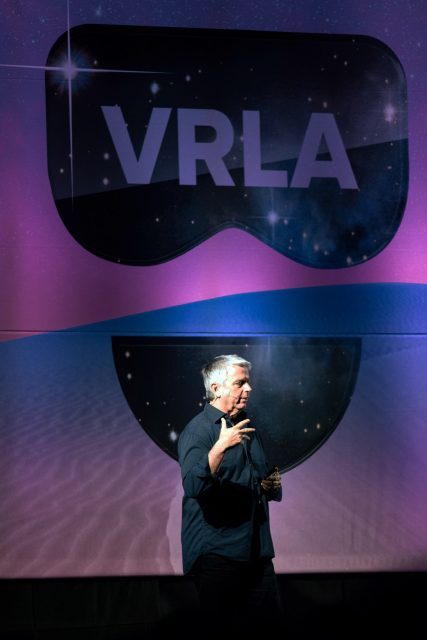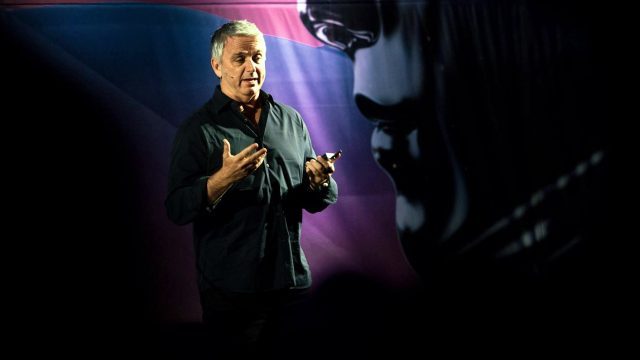At VRLA 2017, Unity CEO and games industry vet John Riccitiello dumped a little cold water wisdom on the hype surrounding the red-hot VR industry. Riccitiello believes VR is coming and it will be huge, but advises that developers stay focused on survival and steer clear of the hype if they want to seize the incredible opportunities in front of them.
There’s a reason people are so excited about VR. Not only are there now a handful of high-end tethered and mobile VR headsets available to consumers—and among them there’s already millions of units in the hands of real customers—but the world’s leading technology companies have announced major VR initiatives, along with the venture capital sector investing in AR/VR companies to the tune of $1.8 billion in 2016 alone.
But, the industry is still in its infancy and still seeking a firm footing that will truly form an ecosystem: a self-sustaining web of hardware builders, software developers, and consumer demand.
John Riccitiello is the CEO of Unity Technologies, one of the world’s leading game engines. Before that he served as both COO and CEO of Electronic Arts (as well as a number of other CEO positions outside the games industry). Under Riccitello’s leadership, Unity last year raised a $181 million investment, reportedly valuing the company around $1.5 billion. That is to say, Unity, Riccitello vision that leads it, are a very important part of the overall gaming industry.

So what was he doing giving a keynote to a few hundred VR developers at VRLA 2017 last month, which, by the measure of the rest of the games conference industry, is a rather small affair?
It’s not where the VR industry is today that brings Riccitello to VRLA, it’s where he believes it will ultimately go. It’s a belief that started at least as far back as when he advised and invested in Oculus prior to the company’s 2014 acquisition by Facebook. It’s a belief that has lead the Unity game engine to be at the forefront of VR and AR hardware support—including Rift, Vive, PlayStation VR, Gear VR, Daydream, and HoloLens—used by two-thirds of AR and VR apps, according to Riccitello.
Despite that conviction, Riccitello was at VRLA to bring a little veteran wisdom to the young VR industry, using his keynote presentation (heading this article) to urge focus, survival, and avoiding the hype until the ecosystem really starts churning.
What I’m not here to do today is to convince you that AR and VR is going to be a big thing. I’m going to assume we agree on that. What I want to talk to you about is when it’s gonna happen, how it’s gonna happen, and what the ingredients are. The point being: I want to try to lay out a framework that I think will actually help the industry, but beyond that, figure out—when you’re putting resources into this marketplace, when you’re investing your time and hard-earned money—when you can expect a return on investment and what that might look like. I think it’s important that we have that so that we [the industry] don’t get too far ahead of ourselves, and maybe running out of that cash or going bankrupt before we really get a chance to get started.
Naturally, Riccitiello spends a good chunk of time evangelizing the Unity game engine, but starting around 10:30 in his presentation, he digs into his personal vision of when the VR industry will take off in earnest, and argues that industry forecasters have taken the VR hype too far.
About a year ago I put this slide up [above]. And it’s not for lack of enthusiasm for the AR and VR world that I own the white line and the industry forecasters own the red line. One of the challenges I think we’re risking right now is so much enthusiasm that’s out there in the marketplace has people forecasting crazy stuff that’s going to happen so near-term that it’s virtually not believable. One of the forecasts I read recently said that the VR/AR marketplace is going to be $164 billion three years from today. Now… the entire game industry, hardware and software—including the juggernaut that is China—is only two-thirds that size, after most of my lifetime building to that point. Now I’m not suggesting [AR/VR] isn’t going to get to $164 billion and then $264 billion, and then $364 billion; I think ultimately the world of AR and VR, the world of 3D compute, is ultimately going to be as big as the internet—it’s going to be trillions, but we’re not there yet, and we have to measure ourselves. So if you look at the shape of my line there, through at least 2022 or thereabouts, I’m a little under the industry forecast. So if you happen to be an industry analyst, and if they show up to events like this, look… I think it hurts us to the degree at which people write articles for the major press and say that our industry is underperforming […] and we should write this off. It is going to work. It’s just not going to work in the timeframe that we like to talk about.

There’s early hardware out now which has allowed what Riccitiello calls a “developer focused industry” to begin slowly growing. But for serious consumer backing, he hones in on the idea of a key “price to content” ratio which has not yet landed in favor of broad consumer adoption.
[…] price and content is absolutely critical for the understanding of when our industry is gonna get to some reasonable level of maturity, and let me explain a little bit of what I’m talking about. Now, price can mean a couple of different things, but ultimately when you’re spending $1,500 or $2,000 to put a brand new tower PC under your desk and you’re tethering it to the back of your head through a head mounted display […] that’s a lot of money. It’s really hard to come up with a product in any form of technology—other than like a brand new car—that sells in any significant volumes at price points like that. The price point is gonna have to come down. […] CPU, GPU, head mounted display—the whole kit—I believe has got to be significantly under $1,000 for the consumer.
And then he turns his attention to today’s blockbuster content creators. When do major franchises and the world’s best content makers start creating serious content for AR and VR? Not until they can justify it with at least a promise of a hundred million devices, Riccitiello says.
Some of the great applications that will show up in AR and VR (and did show up in gaming and mobile) were written by very small teams. And they were ridiculously innovative. But markets matured to scale when major developers brought out their version of Star Wars or Marvel or these other things, and a lot of times these things can cost $20, $30, $40, $50… $100 million to build—all of the sci-fi or superhero movies cost over $100 million to build. And for those products to show up—for them to have a reasonable chance of penetrating a market well enough to break even or better—[…] if there isn’t at least a very near-term probability of 100 million devices in the marketplace that can play it, they won’t build it. They won’t build it because it can’t make money. And so, what needs to change for our market to get to a place that makes any sense at all for you to get the return on investment you want, is we’re gonna need to see the promise of that first 100 million [devices], and then the promise of the second 100 million. A couple hundred million devices creates an umbrella for the entire industry to flourish. And I think we’re a few years away from that.

So when does that happen? When does an individual AR/VR platform bring together the best of the what’s out there today at a price point less than $1,000 dollars and begin to point toward that 100 million device mark?
My sense is we’re going to see that in full flower in 2019, and we’re going to see the beginnings of that shape [of device adoption] in 2018. […] it will happen, it’s guaranteed to happen. It won’t happen at the time-table that people tell us it’s going to happen. It’s going to be slower than that because the pieces still need to come together.
And finally Riccitiello turns toward the exciting opportunity that even the smallest developers find themselves in today. He talks about the hardware makers who are putting out devices today, even when the content isn’t ready for prime time.
[…] if you run into anybody that works for Oculus, or anybody that works for Vive, or Samsung working on Gear, or Magic Leap folks etc. These guys have invested billions. Absolutely invested billions and they have many billions to go. My friend Clay [Bavor, VP of VR] at Google, he’s investing and building… he’s creating something. You know what he’s creating? He’s not creating Google VR. Brendan [Iribe, Head of Rift] and his team are not creating Facebook VR. Gabe [Newell, head of Valve] are not creating VR for Valve. They’re creating the opportunity for you to be in the same position that EA and Activision were in the early ’80s when they created their companies to get the game industry off the ground. They’re creating the same opportunity that [mobile game giants] Supercell and Machine Zone and King had in the world of mobile to get their companies off the ground. This is a simple equation; they created the opportunity, you will create the industry, and I can’t wait.






